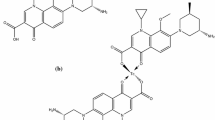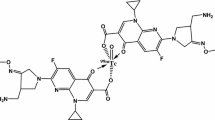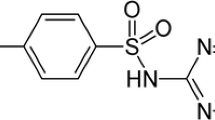Abstract
In the current investigation complexation of the gemifloxacin (GIN) with technetium-99 m (99mTc) and its biological evaluation in artificially Streptococcus pneumoniae (S. pneumoniae) infected rats was assessed as potential S. pneumoniae infection radiotracer. Radiochemically the 99mTc-GIN complex was further analyzed in terms of stability in saline, in vitro stability in serum at 37 °C, in vitro binding with S. pneumoniae and biodistribution in artificially S. pneumoniae (living and heat killed) infected rats. The complex was found 97.25 ± 0.25% radiochemically stable in saline at 30 min after reconstitution. The stability of the 99mTc-GIN complex was decreased to 90.50 ± 0.20% within 240 min after reconstitution. In serum the 99mTc-GIN complex showed stable profile with the appearance of 18.85% free tracer within 16 h of incubation. The 99mTc-GIN complex showed saturated in vitro binding with S. pneumoniae after different intervals. Almost five fold uptake was observed in living S. pneumoniae infected muscle of the rats as compared to the inflamed and normal muscle. No significant difference in the uptake of heat killed S. pneumoniae infected, inflamed and normal muscles of the rats. The high RCP yield in saline, in vitro permanence in serum, in vitro binding with living S. pneumoniae and biodistribution in artificially S. pneumoniae infected rats we recommend the 99mTc-GIN as potential S. pneumoniae infection radiotracer.
Similar content being viewed by others
Avoid common mistakes on your manuscript.
Introduction
The role of Nuclear Medicine Imaging Technology (NMIT) in the diagnosis of infection and its discrimination is widely accepted because of its specificity and accuracy. The Ultrasonography (US), Computerized Tomography (CT) and Magnetic Resonance Imaging (MRI) are the other advance techniques intended for the diagnosis of infection. The results of the US, CT and MRI are unsatisfactory in the early stages of the disease [1, 2].
In the last decade the radiopharmaceuticals developed for infection localization have proven highly accurate and specific [3–15] and our recently reported γ-emitting technetium-99m labeled antibiotics [16–24] intended for infection localization and its discrimination from inflammation, extend our research to develop more sensitive and specific infection radiotracers.
Gemifloxacin (GIN) [7-[(4Z)-3-(aminomethyl)-4-methoxyimino-pyrrolidin-1-yl]-1-cyclopropyl-6-fluoro-4-oxo-1,8-naphthyridine-3-carboxylic acid] (Fig. 1a) is a novel fluoroquinolone broad spectrum antibiotic. It is used for the management of acute bacterial exacerbation of chronic bronchitis induced by Streptococcus pneumoniae (S. pneumoniae), Haemophilus influenzae, Haemophilus parainfluenzae, or Moraxella catarrhalis and community-acquired pneumonia (of mild to moderate severity) induced by Streptococcus pneumoniae including multi-drug resistant strains, Haemophilus influenzae, Moraxella catarrhalis, Mycoplasma pneumoniae, Chlamydia pneumoniae, or Klebsiella pneumoniae. GIN is found more effective against S. pneumoniae than moxifloxacin, gatifloxacin, levofloxacin and ciprofloxacin [25, 26].
The higher antibiotic potency of the GIN against S. pneumoniae has been exploited for the diagnosis of infection caused by S. pneumoniae stain. In the current investigation the complexation of the GIN with 99mTc was studied in terms of stability in saline at different interval up to 240 min, in vitro stability in serum at 37 °C, in vitro binding with S. pneumoniae and biologically in artificially S. pneumoniae infected rats.
Experimental
Materials
Gemifloxacin (GIN) (Shanghai Sciencya Biotechnology Co., Ltd. Shanghai, China), TLC (Merck) and all the other chemicals and solvents of analytical grade (Sigma). RP-HPLC (Shimadzu, Japan) well counter and scalar count rate meter (Ludlum, USA) Dose calibrator (Capintech, USA) and Gamma camera GKS-1000 (GEADE Nuclearmedizine system, Germany).
Methods
Radiocomplexation of the Gemifloxacin (GIN)
99mTc-Gemifloxacin (99mTc-GIN) complex was prepared by reacting the reduce sodium pertechnetate 0.5–5.0 mCi (with 0.5 mCi rise) with 0.5–5 mg (with 0.5 mg increase) GIN in ten different nitrogen gas filled sealed vials. The pHs of the reaction mixtures were set between 5.1 to 6.0 (with 0.1 unit augment). The sodium pertechnetate for the ten different vials were reduced by using stannous chloride 25–250 μL (with 25 μL: μg/μL 0.01 N HCL). After gentle swirling the reaction mixtures were incubated at room temperature and then (the reaction kits) were filtered through Millipore before dispensing.
HPLC characterization
Shimadzu HPLC equipped with SDP-10 AVP, UV detector operating at 254 nm, Packard 500 TR series flow scintillation analyzer, binary pump, using online degasser was used for radiochemical characterization of the 99mTc-GIN complex. A flow rate of 1 mL/min was employed for 15 min using 25 mmol/L triethylaminophosphate (2.25 pH buffer) (TEAP) and methyl alcohol (MetA) as the mobile phases. For 0-3 min (100%: TEAP), 3–6 min (100–75% TEAP), 6–8 min (75–66% TEAP), 8–10 (34–100 MetA), 10–12 (100% MetA) and 12–15 (100% MetA to 100% TEAP) as the mobile phase. The HPLC eluent at different intervals were separately collected and measured for activity using single well counter interface with scalar count rate meter (SWCSCRM).
Radiochemical stability in saline
Radiochemical stability of the 99mTc-GIN complex in saline was determined by using the TLC method. Acetone and ethanol:water:ammonia (2:5:1) were used as two the mobile phases. 0.5 μL of the preparation at different intervals after reconstitution was withdrawn and dotted on the TLC strip. The TLC strip was then developed in acetone and ethanol:water:ammonia (2:5:1) separately. After that the TLC strips were divided into two equal parts and measured for activity in each part using SWCSCRM.
Stability in serum
The stability of the preparation was evaluated in serum at 37 °C for 16 h using the reported procedure [17]. Briefly, 0.2 mL of the preparation was incubated with 1.8 mL of the serum at 37 °C followed by withdrawal of 1 μL aliquots of the reaction mixture at 2, 4, 6, 8, 10, 12 14 and 16 h of incubation. Thereafter, the aliquots were processed, measuring the stability using the TLC procedure. The CH2Cl2:CH3OH (9:1) (v/v) was used as the mobile phase. The developed strips were equally divided into two half and measured for activity using SWCSCRM.
Binding with Streptococcus pneumoniae
The in vitro binding of the S. pneumoniae with 99mTc-GIN complex was investigated using the reported procedure [27]. Briefly, 0.2 mL of the 99mTc-GIN complex was taken in a sterilized test tube containing 0.1 mL of sodium phosphate buffer (Na-PB). Thereafter, 0.8 mL (50%, v/v) 0.01 M acetic acid including 1 × 108 colony forming units (CFU) of S. pneumoniae was supplemented to the test tube. The test tube was then incubated at 4 °C for 1 h at pH 5. The test tube mixture for 10 min was centrifuged at 2000 rpm. The supernatant subsequent to centrifugation was removed and the pellets were resuspended in Na-BP (2 mL) followed by centrifugation at 2000 rpm for 10 min. The uptakes in bacterial pellets at different intervals were measured using SWCSCRM.
Biodistribution in S. pneumoniae infected rats
The distribution of the 99mTc-GIN complex in artificially S. pneumoniae infected rat model was investigated and in vivo uptake in blood, liver, spleen, stomach, intestine, kidney, infected muscle, inflamed and normal muscle was determined at different intervals of the intravenous administration. Healthy eight sprague–dawley rats (weight, 160–200 g) were taken and divided into two groups of four each group A and B. The rats were artificially inflamed by injecting 0.2 mL sterile turpentine oil into their left thigh. Thereafter, group A rats were infected by injecting 0.2 mL of living S. pneumoniae to their right thigh and group B with heat killed S. pneumoniae. After 24 h, 0.5 mL (18.5 MBq) of the 99mTc-GIN complex was injected intravenously to the rats of the group A and B. Thereafter, the rats were executed in accordance to the approved rules and regulations of the Nuclear Medicine Research Laboratory (NMRL) University of Peshawar. The absorption of the 99mTc-GIN complex in blood, liver, spleen, stomach, intestine, kidney, infected muscle, inflamed and normal muscle of the group A and B rats were calculated using SWCSCRM.
Results and discussion
Radiochemistry and HPLC analysis
Different amount of the sodium pertechnetate as the basis of radioactive metal (99mTc)) was separately reduced to the lower oxidation states using stannous chloride dihydrate (25–250 μL with 25 μL rise (μg/μL 0.01 N HCL) as the reducing agent. The reduced radioactive metal was then mixed with different amount of GIN. The optimized amount of the ingredients at which the 99mTc-GIN complex showed maximum (97.25 ± 0.25%) radiochemical purity (RCP) was 3 mCi of sodium pertechnetate, 125 μg/μL 0.01 N HCL, 2 mg of GIN at pH 5.4. The RCP values of the 99mTc-GIN complex are shown in Fig. 2. It was observed that the complex showed more than 90% up to 120 min of the reconstitution at room temperature. The RCP of the complex went down from 97.25 ± 0.25% to 90.50 ± 0.20% within 120 min after the reconstitution.
The 99mTc-GIN complex gave two radiopeaks at 2.8 and 11.1 min of retention as given in Fig. 3. The radiopeak at 2.8 min of retention represents the free pertechnetate and that at 11.1 min the yield of the 99mTc-GIN complex.
The bidentate gemifloxacin (Fig. 1a) tagged by treatment with sodium pertechnetate using the method described earlier [R]. The proposed structure of 99mTc-GIN complex (Fig. 1b) will have a square planner pyramidal geometry with Metal:Ligand ratio of 1:2 using intermolecular complexation by the bidentate ligand.
Figure 4 gives the effect of GIN sodium pertechnetate, stannous chloride amount and pH on the RCP yield of the 99mTc-GIN complex. The 99mTc-GIN complex showed maximum (97.25 ± 0.25%) RCP value at 30 min of the reconstitution by mixing 3 mCi of sodium pertechnetate, 125 μg/μL 0.01 N HCL, 2 mg of GIN at pH 5.4. The RCP values remained low in either cases of increasing or decreasing the amount of the reacting specifies.
Stability in serum
In vitro stability of the 99mTc-GIN complex at 37 °C for 16 h is given in Fig. 5. The complex showed in vitro stability in serum with 18.85% free technetium moiety up to 16 h. Between 1 to 4 h the complex was more than 90% tagged.
Binding with Streptococcus pneumoniae
Figure 6 gives the in vitro binding behaviour of the 99mTc-GIN complex at 30, 60, 90 and 120 min. It was observed that the complex showed saturated in vitro binding reaching the maximum value of 63.25% within 90 min.
Biodistribution in S. pneumoniae infected rats
The percent absorption of the 99mTc-GIN complex in per gram of the blood, liver, spleen, stomach, intestine, kidney, infected muscle, inflamed and normal muscle of the artificially S. pneumoniae infected healthy sprague–dawley rats (weight, 160–200 g) is given in Table 1. The radioactivity observed per gram of the blood after I.V injection of the complex was 22.50 ± 0.20% at 30 min which was reduced to 5.00 ± 0.22% within 120 min in group A. Similar behaviour was noted in group B where the radioactivity level decreased from 20.80 ± 0.22 to 4.80 ± 0.20% within 120 min. The uptake of the 99mTc-GIN complex in liver, spleen, stomach and intestine showed similar behaviour where the uptake was initially high that fall to lower values within 120 min. In kidney a opposite behaviour was noted wherein the radioactivity increased from 7.45 ± 0.24 to 24.50 ± 0.20% and 8.00 ± 0.20 to 24.00 ± 0.24% within 120 min in both group A and B, respectively. The 99mTc-GIN complex showed similar normal blood circulatory and urinary system for excretion as shown by the reported agents [16–18].
The absorption of the complex in the infected muscle of the rats was approximately five times higher than the inflamed and normal muscles in group A as given in Fig. 7. No significant change has been observed between the values of the tracer uptake in inflamed and normal muscles.
Conclusion
The 99mTc-GIN complex prepared by reacting 3 mCi of sodium pertechnetate in the presence of 125 μL of stannous chloride dihydrate (1 μg/μL in 0.01 N HCl) with 2 mg of GIN at a pH 5.4 showed high stability in saline, in vitro stability in serum, saturated in vitro binding with Streptococcus pneumoniae and highly targeted biodistribution in artificially infected rats. Based on these results we recommend the 99mTc-GIN complex specifically as a potential Streptococcus pneumoniae infection imaging agent.
References
Gallagher H, Ramsay SC, Barnes J, Maggs J, Cassidy N, Ketheesan N (2006) Neutrophil labeling with [99mTc]-technetium stannous colloid is complement receptor 3-mediated and increases the neutrophil priming response to lipopolysaccharide. Nucl Med Biol 33:433
Stumpe KDM, Dazzi H, Schaffner A, Schulthess GK (2000) Infection imaging using whole-body FDG-PET. Eur J Nucl Med 27:822
Chattopadhyay S, Das SS, Chandra S, De K, Mishra M, Sarkar BR, Sinha S, Ganguly S (2010) Synthesis and evaluation of 99mTc-moxifloxacin, a potential infection specific imaging agent. Appl Radiat Isot 68:314
Motaleb MA (2007) Preparation of 99mTc-cefoperazone complex, a novel agent for detecting sites of infection. J Radioanal Nucl Chem 272:167
Motaleb MA (2007) Preparation and biodistribution of 99mTc-lomefloxacin and 99mTc-olfloxacin complex. J Radioanal Nucl Chem 272:95
Zhang J, Guo H, Zhang S, Lin Y, Wang X (2008) Synthesis and biodistribution of a novel 99mTcN complex of ciprofloxacin dithiocarbamate as a potential agent for infection imaging. Bioorg Med Chem Lett 18:51
Roohi S, Mushtaq A, Jehangir M, Ashfaq MS (2006) Synthesis, quality control and biodistribution of 99mTc-Kanamycin. J Radioanal Nucl Chem 267:561
Oh SJ, Ryu J, Shin JW, Yoon EJ, Ha H, Cheon JH, Lee HK (2002) Synthesis of 99mTc-ciprofloxacin by different methods and its biodistribution. Appl Radiat Isot 57:193
EL-Gany EA, EL-Kolaly MT, Amine AM, EL-Sayed AS, Abdel-Gelil F (2005) Synthesis of 99mTc-pefloxacin:A new targeting agent for infectious foci. J Radioanal Nucl Chem 266:131
Motaleb MA (2009) Preparation, quality control and stability of 99mTc-sparafloxacin complex, a novel agent for detecting sites of infection. J Label Compd Radiopharm 52:415
Xia J, Wang Y, Yu J, Li S, Tang L, Zheng M, Liu X, Li G, Cheng D, Liang S, Yin D (2008) Synthesis, in vitro and in vivo behavior of 188Re(I)-tricarbonyl complexes for the future functionalization of biomolecules. J Radioanal Nucl Chem 275:325
Zhang J, Wang X, Jin C (2007) Synthesis and biodistribution of the 99mTc(CO)3-DEDT complex as a potential new radiopharmaceutical for brain imaging. J Radioanal Nucl Chem 272:91
Djokic DD, Jankovic DL, Stamenkovic LL, Pirmettis I (2004) Chemical and biological evaluation of 99mTc (CO)3 and 99mTc complexes of some IDA derivatives. J Radioanal Nucl Chem 260:471
Xia J, Long S, Yu J, Wang Y, Cao Z (2009) Pyridyl derivatives provide new pathways for labeling protein with fac-[188Re(CO)3(H2O)3]+. J Radioanal Nucl Chem 281:493
Zhang JB, Wang XB, Jin C (2006) Synthesis of 99mTc(CO)3-NOET via [99mTc(OH2)3(CO)3]+ precursor and comparative biological studies with 99mTcN-NOET. J Radioanal Nucl Chem 269:227
Qaiser SS, Khan AU, Khan MR (2010) Synthesis, biodistribution and evaluation of 99mTc-Sitafloxacin kit : A novel infection imaging agent. J Radioanal Nucl Chem 284:189
Shah SQ, Khan AU, Khan MR (2010) Radiosynthesis of 99mTc–nitrifuratonin a novel radiotracer for in vivo imaging of Escherichia coli infection. J Radioanal Nucl Chem. doi:10.1007/s10967-010-0697-z
Shah SQ, Khan AU, Khan MR (2010) Radiosynthesis and biodistribution of 99mTc-rifampicin: a novel radiotracer for in vivo infection imaging. Appl Radiat Isot 68:2255
Shah SQ, Khan AU, Khan MR (2010) 99mTc-Novobiocin: a novel radiotracer for infection imaging. Radiochim Acta (in press)
Shah SQ, Khan AU, Khan MR (2010) Radiosynthesis, biodistribution and scintigraphy of the 99mTc–teicoplanin complex in artificially infected animal models. J Label Compd Radiopharm. doi:10.1002/jlcr.1834
Shah SQ, Khan AU, Khan MR (2010) Radiosynthesis and biological evaluation of 99mTcN–sitafloxacin dithiocarbamate as a potential radiotracer for Staphylococcus aureus infection. J Radioanal Nucl Chem. doi:10.1007/s10967-010-0833-9
Shah SQ, Khan AU, Khan MR (2010) Radiosynthesis and biodistribution of 99mTcN–garenoxacin dithiocarbamate complex a potential infection imaging agent. J Radioanal Nucl Chem. doi:10.1007/s10967-010-0871-3
Shah SQ, Khan AU, Khan MR (2010) Radiosynthesis and biological evolution of 99mTc(CO)3–sitafloxacin dithiocarbamate complex: a promising Staphylococcus aureus infection radiotracer. J Radioanal Nucl Chem. doi:10.1007/s10967-010-0880-2
Shah SQ, Khan AU, Khan MR (2010) 99mTc(CO)3–Garenoxacin dithiocarbamate synthesis and biological evolution in rats infected with multiresistant Staphylococcus aureus and penicillin-resistant Streptococci. J Radioanal Nucl Chem. doi:10.1007/s10967-010-0892-y
Blondeau JM, Tillotson G (2007) Gemifloxacin for the management of community-acquired respiratory tract infections. Antibiotiques 9:173
Al-Hadiya BMH, Khady AA, Mostafa GAE (2010) Validated liquid chromatographic-fluorescence method for the quantitation of gemifloxacin in human plasma. Talanta 83:110
Welling MM, Paulusma-Annema A, Batler HS, Pauwels EKJ, Nibbering PH (2000) Technetium-99m labelled antimicrobial peptides discriminate between bacterial infections and sterile inflammations. Eur J Nucl Med 27:292
Author information
Authors and Affiliations
Corresponding author
Rights and permissions
About this article
Cite this article
Shah, S.Q., Khan, M.R. Radiolabeling of gemifloxacin with technetium-99m and biological evaluation in artificially Streptococcus pneumoniae infected rats. J Radioanal Nucl Chem 288, 307–312 (2011). https://doi.org/10.1007/s10967-010-0916-7
Received:
Published:
Issue Date:
DOI: https://doi.org/10.1007/s10967-010-0916-7











